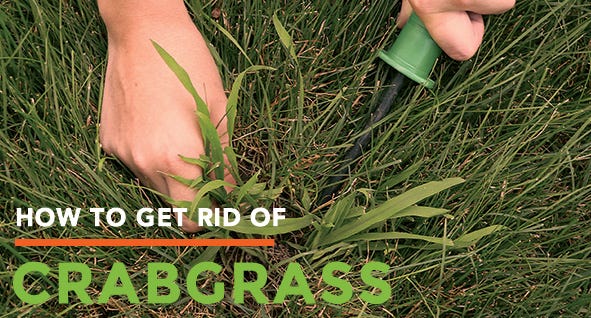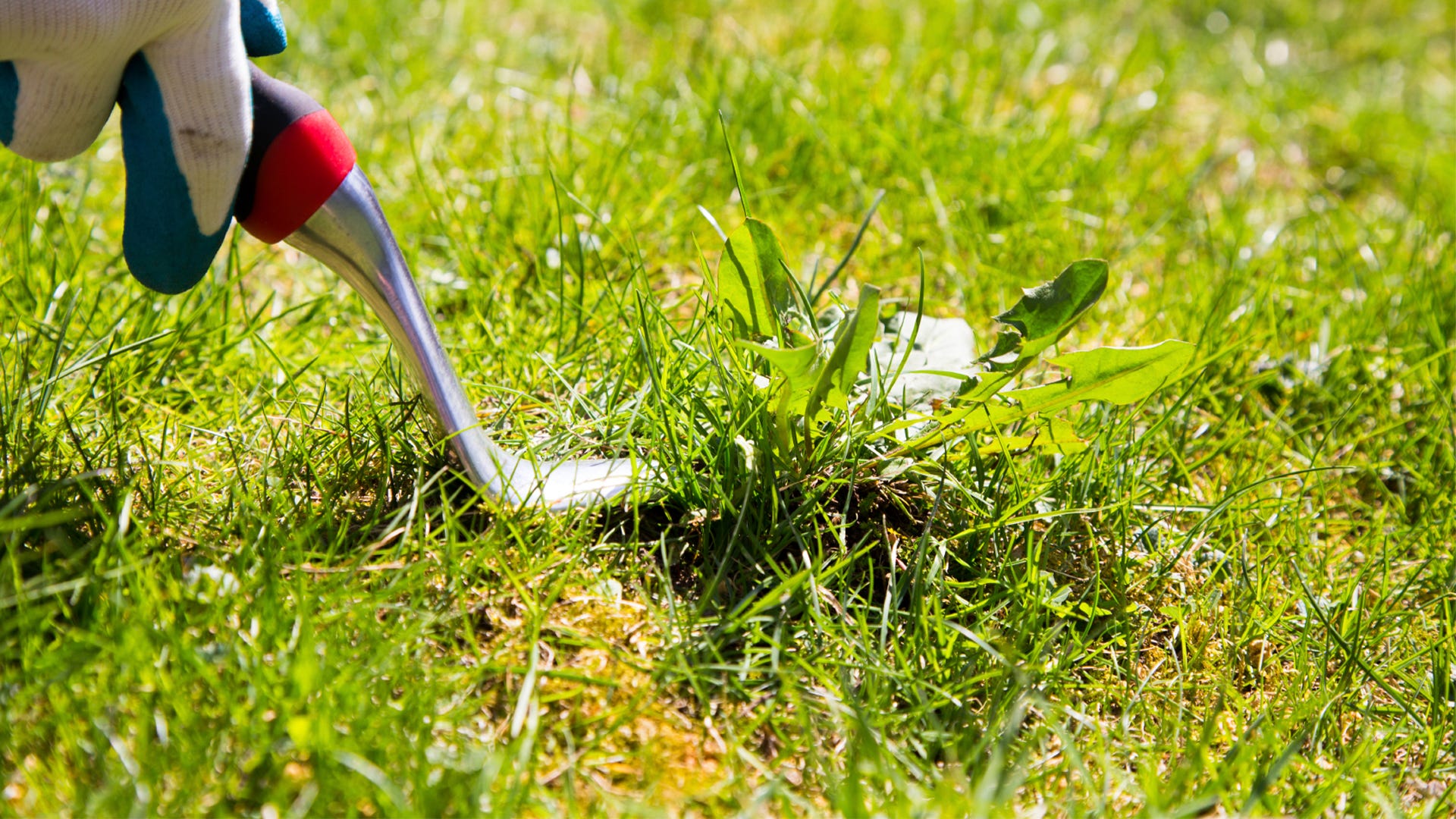
Throughout North America, homeowners confront an annual scourge that can turn a lush, smooth emerald carpet into a weedy mess: crabgrass. Specifically, large crabgrass (Digitaria sanguinalis) — which also goes by the name hairy crabgrass — and smooth crabgrass (Digitaria ischaemum) can invade lawns, flower beds and vegetable gardens, rapidly becoming a nuisance. When one plant can produce an estimated 150,000 new crabgrass seeds from each plant, you know it’s trying to take over your yard!
What is Crabgrass and Why Not Just Let it Grow?
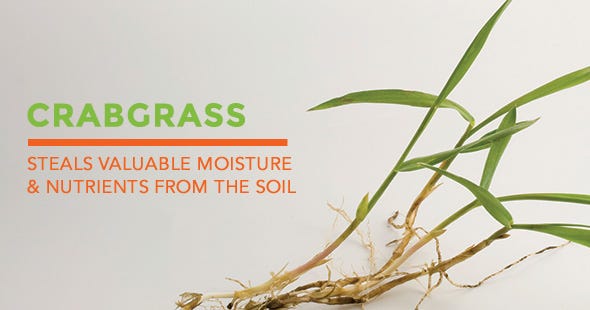
Crabgrass and other unwanted weeds steal valuable moisture and nutrients from the soil, taking them away from plants you value such as lawn grasses, flowers and vegetables. Crabgrass can also make a lawn look unkempt. As an annual grass sown from seed, when the plants die in the fall, they leave gaping holes throughout the lawn during the winter.
The first step in managing and repelling any intruder is to identify the enemy. Once you learn what crabgrass looks like, it’s important to learn several methods of controlling this weedy grass. Biological control of crabgrass is easier than you’d think, but there are also several crabgrass control products available at your local nursery and garden center that kill unwanted crabgrass or prevent it from sprouting in the first place.
What Does Crabgrass Look Like?
To the casual observer, all grass may look the same — but look again. Peer closely at a spot on your lawn. You’ll notice that the smooth green carpet is actually composed of individual blades of various grass species. Lawns throughout North America are sown with cool season grass, warm season grass or a mixture of both types. The type of grass grown in your yard may differ from your neighbor’s significantly, depending on where you bought the seed, when the lawn was established and which varieties you chose for the lawn.
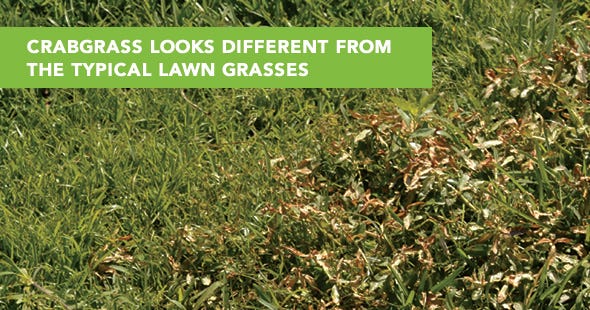
You can identify crabgrass by looking for:
- 1. Clumps or clusters of grass that look slightly different from the surrounding grass areas.
- 2. Bare patches of soil. Areas that sprout new grass without seeding may harbor crabgrass.
Large crabgrass has:
- Seedlings with light-green leaves that are hairy on the upper surface.
- Leaves on mature plants that are about three inches long and hairy.
- Branches that are two to five inches long.
On the other hand, smooth crabgrass:
- Grows to a mature height of six inches.
- Sets seed when it’s cut way back — even down to one-quarter of an inch tall, smooth crabgrass can still produce seeds.
- Has seedling leaves that are light green and smooth.
- Has leaf blades that are pointy.
- Forms branches on its stems, with the branches about 1/2 inch to 2 1/2 inches long.
Of the two types, smooth crabgrass is a lot more common in lawns because it can survive repeated close mowing. Large crabgrass doesn’t like a close shave, so it doesn’t thrive as well in groomed areas such as lawns, but it grows more easily in open pastures and fields.
How to Get Rid of Crabgrass Naturally
If you’ve taken a walk around your property and recognized crabgrass growing among the Kentucky bluegrass, zoysia and fescue, don’t despair. There are several steps you can take to make your yard inhospitable to crabgrass plants and seeds.
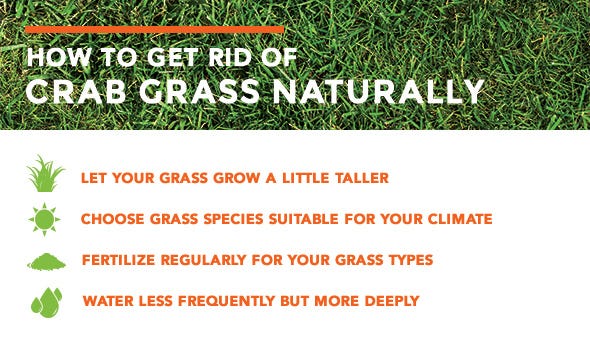
To take back control of your lawn from the crabgrass invaders, try changing a few of your gardening and lawn care practices.
- Let your grass grow a little taller: Crabgrass loves full sunlight. When you cut your lawn very short, the blades of desirable grass can’t shade the rest of the lawn. Crabgrass can seed in those sunny areas. Various grass species should be mowed at different heights, so check with your local Cooperative Extension office for the typical species sown in your part of the country and the height at which they should be mowed. If you think your lawn contains a blend of grasses, err on the side of caution and let your lawn grow a little taller.
- Choose grass species suitable for your climate: The healthier your overall lawn, the less room there is for crabgrass to grow. Species suitable for your climate will have an easier time setting down roots and growing into a healthy, vigorous lawn.
- Fertilize regularly for your grass types: Fertilizer encourages growth, and a flush of new lawn growth will crowd out crabgrass seedlings.
- Water less frequently but more deeply: One common mistake homeowners make is to water their lawns lightly and frequently. A deep watering every few days is actually better for your grass and discourages crabgrass. Allowing your lawn to dry out between watering actually encourages grass to put down deeper roots. Light watering encourages shallow surface roots that can dry out easily.
Controlling Crabgrass in Garden Areas
Crabgrass that invades flower beds or vegetable gardens should also be controlled through simple horticultural practices. Pulling crabgrass by hand is the preferred, albeit tiring, method. You can also hoe the area around the plants to pull up crabgrass by the roots. Mulching your garden with wood chips or hay reduces weeds and increases natural moisture retention near the roots of plants, a plus for drought-prone areas.
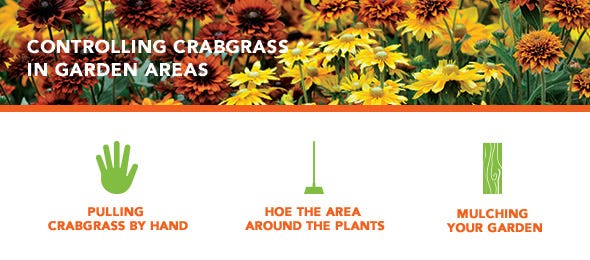
Crabgrass Preventer
Crabgrass preventers are good at stopping crabgrass seeds from germinating. Since each crabgrass plant produces a huge volume of seeds — and even small plants can begin producing seeds when relatively young — preventing seeds from germinating in the soil is a useful crabgrass prevention tip.
Concern® Weed Prevention Plus® is an excellent crabgrass preventative made from corn gluten meal. It kills the roots of sprouting seeds, so it nips germinating crabgrass as it emerges, but it won’t harm established lawns and gardens. As long as your existing flowers and vegetables have several sets of leaves, you can use Concern® Weed Prevention Plus® near your plants.
As previously mentioned, a healthy lawn prevents crabgrass from gaining a foothold. Keep your lawn healthy with Ringer® Lawn Restore® II Fertilizer. Underneath that lovely lawn is a thriving ecosystem of fungi, bacteria, insects and other living creatures that contribute to healthy soil and grass. Ringer® Lawn Restore® II Fertilizer supports and restores this healthy ecosystem so your grass can thrive. It provides micronutrients lawn grass craves in a balanced, economical formula.
If all else fails and you need to spot-kill patches of crabgrass, there is a product to take care of the job: Safer® Brand Fast Acting Weed and Grass Killer. This weed killer features a simple pump spray bottle to kill individual crabgrass plants. It’s fast acting, and the lawn can be reseeded with your chosen grass seed blend in as little as two days after application. A larger size concentrate is also available.
For more information on conquering crabgrass, your local Cooperative Extension Office may have pamphlets, flyers or information to help you maintain a healthy lawn. They will also have lists of good grass seed varieties to plant in your area and the proper mowing height to encourage a healthy lawn.
